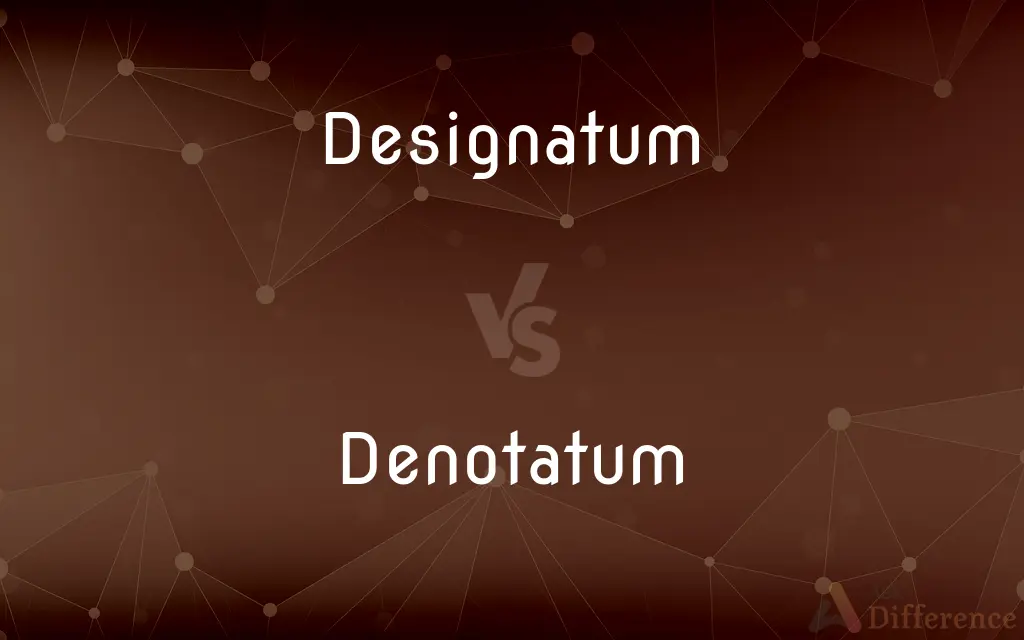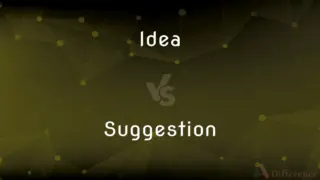Designatum vs. Denotatum — What's the Difference?
By Urooj Arif & Fiza Rafique — Updated on March 15, 2024
Designatum refers to the intended meaning or concept a symbol represents, whereas denotatum is the actual object or set of objects a term refers to.

Difference Between Designatum and Denotatum
Table of Contents
ADVERTISEMENT
Key Differences
Designatum involves the concept or idea that a sign or symbol is intended to represent. It's about the mental or abstract representation that creators or users of the symbol have in mind. This concept is crucial in fields like semantics, semiotics, and the philosophy of language, where understanding how symbols and terms connect with meanings is essential. Denotatum, on the other hand, pertains to the concrete objects or entities that a word or phrase refers to in the real world. It's more about the external reality that a term points to, rather than the internal concept or intention behind it. In linguistics and logic, distinguishing between the idea of something and its real-world instances is fundamental for clear communication and analysis.
The relationship between designatum and denotatum highlights the layered nature of language and representation. While designatum focuses on the intended meaning behind a symbol, denotatum deals with the symbol's practical reference in reality. This distinction helps clarify how language operates on both abstract and concrete levels.
Understanding both terms is vital for exploring how language and thought interact. Designatum underscores the role of intention and concept in communication, emphasizing the mental processes involved in using and interpreting symbols. Denotatum brings attention to language's ability to refer to and describe the tangible world, grounding abstract thoughts in reality.
The nuances between designatum and denotatum also have implications for the study of semantics and the philosophy of language. They help in analyzing how symbols function, how meanings are constructed, and how language relates to the objects and entities it describes. This analysis is crucial for fields ranging from linguistics to artificial intelligence, where the relationship between symbols, their meanings, and their referents are foundational concerns.
Comparison Chart
Definition
The intended concept or idea a symbol represents.
The actual object(s) a term refers to.
ADVERTISEMENT
Focus
Abstract concept or meaning.
Concrete objects or entities.
Related Field
Semiotics, semantics, philosophy of language.
Linguistics, logic, philosophy of science.
Importance
Highlights intention and concept in communication.
Emphasizes language's referential function.
Example
The word "unicorn" represents a mythical creature.
The word "tree" refers to actual plants with trunks and leaves.
Compare with Definitions
Designatum
The abstract representation a term aims to convey.
The designatum of pi is the ratio of a circle's circumference to its diameter.
Denotatum
The real-world entity a term refers to.
The denotatum of Washington includes both a state and a U.S. capital city.
Designatum
A concept or idea that a sign represents.
The designatum of justice involves notions of fairness and moral righteousness.
Denotatum
The specific objects or things signified by a word.
The denotatum of apple are the edible fruits produced by apple trees.
Designatum
The intended meaning behind a symbol or term.
The designatum of phoenix is a mythical bird that symbolizes rebirth.
Denotatum
The actual referents of a linguistic expression.
The denotatum of Mount Everest is the Earth's highest mountain above sea level.
Designatum
The mental image associated with a symbol.
The designatum of dragon conjures images of powerful, mythical creatures.
Denotatum
The concrete examples of a concept.
The denotatum of bird includes sparrows, eagles, and penguins.
Designatum
The target concept of a linguistic expression.
The designatum of love encompasses a wide range of feelings and attitudes.
Denotatum
The set of objects or entities a symbol picks out in the world.
The denotatum of car consists of various types of motor vehicles.
Designatum
(semantics) That which is named or designated by a linguistic term.
Denotatum
Something that is denoted; a referent.
Designatum
Something (whether existing or not) that is referred to by a linguistic expression
Denotatum
The actual object referred to by a linguistic expression.
Denotatum
An actual object referred to by a linguistic expression
Common Curiosities
Can a term have multiple denotata but one designatum?
Yes, a term can refer to multiple specific objects (denotata) while having a single conceptual meaning (designatum).
How do designatum and denotatum relate to semantics?
They are fundamental concepts in semantics, exploring the relationship between symbols, their meanings, and their references.
How does designatum affect interpretation of texts?
The intended meanings (designatum) influence how texts are interpreted, as readers seek to understand the concepts behind the words.
Why is understanding designatum important in communication?
Understanding designatum helps grasp the intended meanings and concepts behind symbols, facilitating clearer communication.
Can denotatum change over time?
Yes, the set of objects a term refers to (denotatum) can evolve as new examples emerge or usage shifts.
Do designatum and denotatum apply to non-verbal symbols?
Yes, these concepts can apply to any symbols, including non-verbal ones, in understanding their intended meanings and real-world references.
What is the main difference between designatum and denotatum?
Designatum is about the intended concept a symbol represents, while denotatum refers to the actual objects the symbol describes.
How do designatum and denotatum interact in abstract concepts?
For abstract concepts, designatum is crucial for understanding the intended idea, while denotatum might be less concrete or direct.
How do new technologies affect the designatum and denotatum of terms?
New technologies can introduce new objects (denotata) and concepts (designata), evolving the meanings and references of terms.
Are designatum and denotatum concepts only relevant in English?
No, these concepts are relevant in any language, as they deal with universal aspects of meaning and reference in communication.
Can a symbol have a denotatum but no designatum?
Theoretically, a symbol could refer to real-world objects without conveying a clear, intended concept, but typically, symbols have both aspects.
Why is the distinction between designatum and denotatum important in philosophy?
It helps analyze how language connects with reality and thought, exploring the nature of meaning, reference, and representation.
Does the designatum of a term always match its denotatum?
Not always; misunderstandings or shifts in usage can lead to discrepancies between intended meanings and actual references.
Can one symbol have multiple designata?
Usually, a symbol has a primary intended concept, but it can convey multiple related meanings depending on context and interpretation.
How does context influence designatum and denotatum?
Context can affect how a symbol's intended meaning is understood (designatum) and which objects it is taken to refer to (denotatum).
Share Your Discovery

Previous Comparison
Idea vs. Suggestion
Next Comparison
Mimic vs. MockAuthor Spotlight
Written by
Urooj ArifUrooj is a skilled content writer at Ask Difference, known for her exceptional ability to simplify complex topics into engaging and informative content. With a passion for research and a flair for clear, concise writing, she consistently delivers articles that resonate with our diverse audience.
Co-written by
Fiza RafiqueFiza Rafique is a skilled content writer at AskDifference.com, where she meticulously refines and enhances written pieces. Drawing from her vast editorial expertise, Fiza ensures clarity, accuracy, and precision in every article. Passionate about language, she continually seeks to elevate the quality of content for readers worldwide.
















































